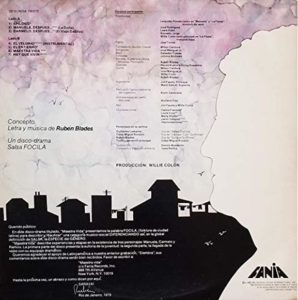This post is also available in:
 Español
Español
It’s been 40 years since Ruben Blades released the masterpiece “Maestra Vida“, a double-album describing the life of its protagonist in a Latino neighborhood.
This was an audacious groundbreaking recording of a musical “novela“, similar to previous musical stories, but much more elaborate.
A Musical “Novela”
What I mean by “musical novela” is the telling of a story throughout various songs. Some call it an “opera”, but I disagree with using that term.
This is not the first time that is done. Actually it’s the 3rd time its done with Salsa music. Larry Harlow’s “Hommy” (1973) and “La Raza Latina” (1977) preceded “Maestra Vida“.
“Hommy” centers around the birth and life of a child born blind, who feels and loves the vibration of the music, particularly the drums. He grows up to become a great “rumbero“.
“La Raza Latina” is about the story of the evolution of Salsa music. Ruben Blades participated in this one singing one song.
“Maestra Vida” centers around the life of Carmelo DaSilva, from courtship of his future wife Manuela, to the birth of his son Ramiro, all the way to old age of Manuela and death of Carmelo.
“Maestra Vida” is Ruben Blades Masterpiece

What sets apart “Maestra Vida” from “Hommy” and “La Raza Latina” is the depth to which Ruben Blades develops the story, including the secondary characters and the scene.
“Hommy” is all about the child protagonist. Its well-known that Harlow took The Who’s “Tommy” and converted it to Salsa music. The main topic of the story been identical, and the even the name is extremely similar. However, although there are secondary characters that help tell the story, they all talk about Hommy and not about them. The father, the doctor, the “Gracia Divina“, the “Heladero“, the godfather….all sing about Hommy, but we know little about them.
In “Maestra Vida” we not only get to know Carmelo, but also get to know Manuela, Ramiro, and even bar owner Vava Quiñonez. Throughout the story, we get to know them and also get familiar with the scene. We know about the streets, about the poverty of the neighborhood, like when his son Ramiro is born, he Carmelo sings…
“se ha formado una gran fiesta,
..todo el barrio esta conmigo,
..como nadie tiene plata,
..que to’ el barrio sea el padrino”
..or even of the general frustration with politics in “Dejenme Reir“, where he sings…
“..para empezar,
..el culpable de mi infierno,
..es el maldito gobierno,
..que ha resultado incapaz…”
“Maestra Vida” is a full story told in Salsa music. Ruben Blades calls it FOCILA = folklore de ciudad latinoamericana (folclore of a Latin American city). Ruben’s mother Anoland plays the young Manuela, beautifully singing the bolero “Yo Soy Una Mujer” to counter the “machista” insinuations in “Manuela” and “Como Tu“.
Some songs are strong and lively, others more subtle. But at the end of the day, “Maestra Vida” is a masterpiece if you take the time to go through its two albums.


[…] Rubén Blades, Andy Montañez, José Nogueras, Danny Rivera, Alex D’Castro, Ismael Miranda, Victoria Sanabria, Giovanni Hidalgo, Juan José Hernández, Prodigio Claudio, and the Ernesto Ramos Antonini Symphony Orchestra are just some of the artists who contributed their art to“Tiempo de Amar“. […]
[…] still had his orchestra with which he performed regularly. For that first concept album, he invited Ruben Blades, Rafael Ithier (alone), Conjunto Quisqueya, and of course, his band singer Roberto Lugo. José […]
[…] of 1 hour 45 minutes. That’s 105 minutes compared, for example, to the double-album of “Maestra Vida” (which I just recently wrote about) which has about 84 minutes of music. That’s the […]